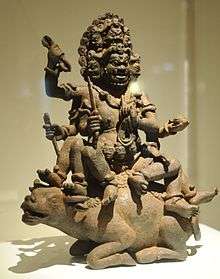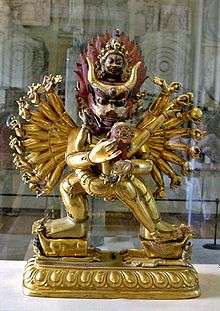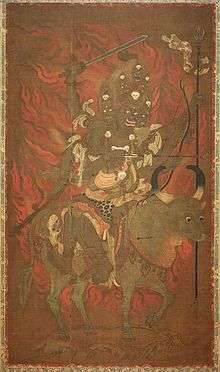Yamantaka
Yamāntaka (Sanskrit: यमान्तक Yamāntaka) or Vajrabhairava (Tibetan: གཤིན་རྗེ་གཤེད་, རྡོ་རྗེ་འཇིགས་བྱེད།, Wylie: gshin rje gshed; rdo rje 'jigs byed ; simplified Chinese: 大威德金刚; traditional Chinese: 大威德金剛; pinyin: Dà Wēidé Jīngāng; Korean: 대위덕명왕 Daewideok-myeongwang; Japanese: 大威徳明王 Daiitoku-myōō; Mongolian: Эрлэгийн Жаргагчи Erlig-jin Jarghagchi) is the "destroyer of death" deity of Vajrayana Buddhism.[1] Sometimes he is conceptualized as "conqueror of the lord of death".[2] Of the several deities in the Buddhist pantheon named 'Yamāntaka', the most well known, also called as 'Vajrabhairava' belongs to the Anuttarayoga Tantra class of deities popular within the Gelug school of Tibetan Buddhism.

Etymology
Yamāntaka is a Sanskrit name that can be broken down into two primary elements: Yama (यमा), –the god of death; and antaka (अन्तक) –destroyer.[3] Thus, Yamāntaka means “Destroyer of Death” or "Conqueror of Death".[2][4] One historic source of name follows Kalantaka, an aspect of the Hindu god Shiva who saves his follower from the clutches of death Yama and is seen as the deity of adherence and origin of the Mahamrityunjaya Mantra of Buddhism and Hinduism.
While Yamāntaka is therefore Yama's nemesis, his representation mirrors Yama in many ways: He too often rides a buffalo and often depicted with a buffalo's head.
Because of this mirroring of appearance and similarity in name, it is not hard to find texts and books (which would appear to be reliable sources of much material) conflate both Yamāntaka and Yama as being the same deity when they are not.
Within Buddhism, "terminating death" is a quality of all buddhas as they have stopped the cycle of rebirth, samsara. So Yamāntaka represents the goal of the Mahayana practitioner's journey to enlightenment, or the journey itself: On final awakening, one manifests Yamāntaka – the ending of death.
Outline

Yamāntaka is a wrathful expression of Mañjuśrī, the Samyaksambuddha of wisdom who, in other contexts, also functions as a dharmapala or a Heruka. Yamāntaka manifests in several different forms, one of which [5] has six legs, six faces and six arms holding various weapons while sitting or standing on a water buffalo. The topmost face is the wrathful aspect of Mañjuśrī, with a red face below it. The other faces are yellow, dark blue, red, black, white, grey, and brown. Each face has three eyes. Common representations also depict thirty-two hands and sixteen legs. [6]
Yamantaka in Japanese Buddhism
In Japanese esoteric teachings, Dai Itoku-Myoo is the wrathful emanation of Amida and is pictured with six faces, legs and arms holding various weapons while sitting on a white ox.[7]
Gallery
 The Japanese equivalent, Daiitoku myōō.
The Japanese equivalent, Daiitoku myōō. Yamantaka-Vajrabhairava mandala
Yamantaka-Vajrabhairava mandala- In Hinduism, Yama (Sanskrit: यम), is the lord of death.
 Yamantaka in a Beijing Buddhist temple.
Yamantaka in a Beijing Buddhist temple.
See also
References
- John Whalen-Bridge; Gary Storhoff (2009). Emergence of Buddhist American Literature, The. State University of New York Press. p. 170. ISBN 978-1-4384-2659-4.
- Buswell, Robert Jr; Lopez, Donald S. Jr., eds. (2013). Princeton Dictionary of Buddhism (Yamantaka). Princeton, NJ: Princeton University Press. p. 1020. ISBN 9780691157863.CS1 maint: ref=harv (link)
- Williams, Monier (1899). Sanskrit-English Dictionary, A. p. 846.
- Getty, Alice (1914). The gods of northern Buddhism, their history, iconography, and progressive evolution through the northern Buddhist countries. Oxford: The Clarendon press. pp. 145–146.
- "His Holiness the Dalai Lama confers the Solitary Hero Yamantaka empowerment in Bodh Gaya | Central Tibetan Administration". tibet.net. Retrieved 2018-12-31.
- Kinley Dorjee, Iconography in Buddhism, Thimphu, Bhutan: Blue Poppy, 2018, 63.
- Coulter, Charles Russell; Turner, Patricia (2013). Encyclopedia of Ancient Deities. Routledge. p. 140. ISBN 9781135963903.
- Dallapiccola, Anna L. (2002). "Kalarimurti; Kalaharamurti or Kalantakamurti". Dictionary of Hindu Lore and Legend. London: Thames and Hudson Ltd. ISBN 0-500-51088-1. Retrieved 16 May 2011.
Bibliography
- Gonsalez, David (2011). The Roar of Thunder: Yamantaka Practice and Commentary. Snow Lion Publications. ISBN 978-1-55939-387-4.
- Ra Yeshé Sengé (2015). The All-Pervading Melodious Drumbeat: The Life of Ra Lotsawa. Translated with introduction and notes by Bryan J. Cuevas. Penguin Classics.
External links
| Wikimedia Commons has media related to Yamantaka. |